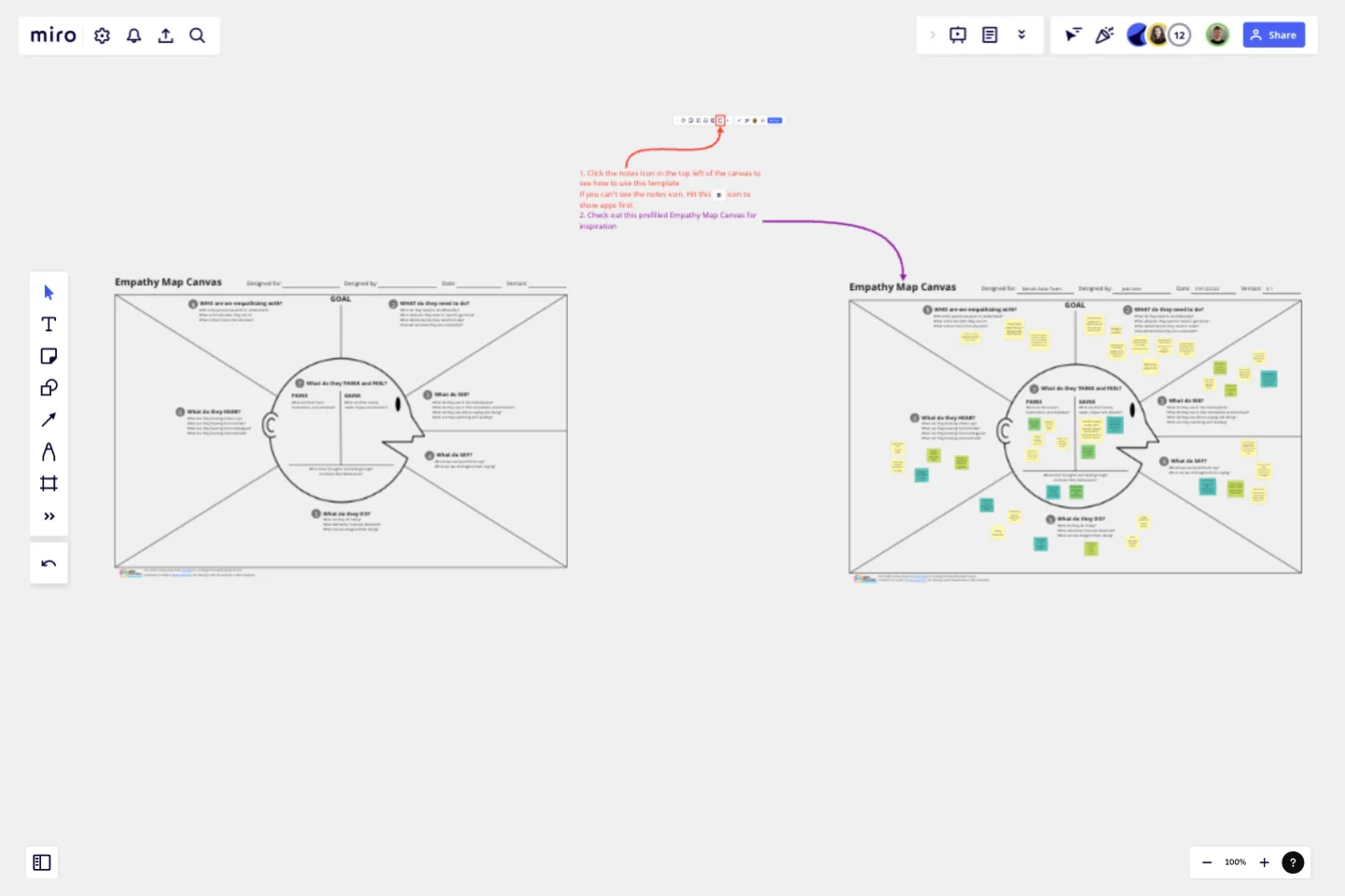Empathy Map Canvas by Jack León
The empathy map, developed by Dave Gray, founder of XPLANE, takes user personas to a whole new level. It puts you in the shoes of your users.
How to use the Empathy Map Canvas
This is best done in a collaborative environment with a cross-functional team and a variety of backgrounds. Frankly, it can be a little tiresome to do on your own, and you're likely to cut corners as a result 🙂 Ideally this exercise is facilitated by someone who has experience running workshops.
Step 1. The Goal
The Goal consists of 2 parts, numbered 1 and 2 on the canvas.Number 1, the description of a person representing your user, their role, and the specific situation that you are interested in helping with.Number 2, what they're trying to do. This is could be a part of a job, or a decision they need to make. It is important to articulate what success looks like for your user.This part is normally led by a Product Owner or a UX lead or analyst.Make sure everyone understands who the user is, what the user is trying to do, and the context within which the behavior is being performed.
Step 2. Around the Head
Now go around the outside of “The Big Head” following the numbers from 3 through to 6. Everyone grabs a bunch of sticky notes and joins in, trying to imagine the world from the user’s perspective.Everyone should spend around 5 minutes on each area; SEE, SAY, DO and HEAR. A great way to run this part of the exercise is using the working together alone technique. Everyone is given time to come up with their own ideas, followed by a quick tidy-up. The tidy-up phase is optional and might consist of a quick deduplication, a brief discussion if any notes are not clear, and sorting of the notes if relevant. Do this for each section from 2 to 6.
Step 3. Inside the Head
Now we are going inside the head of our user. Before you do, the facilitator should take 5 minutes to quickly summarise all the sticky notes in sections 1 through to 6. This will give everyone time to internalize and expand their empathy for the user.Section 7 has 3 areas, Pains, Gains, and others. As the canvas states, Pains are things that are worrying our user, Gains are things our user wants and others is an area to put notes which are hard to classify but feel important.Again, have the team work together alone, giving everyone 8-10 minutes on section 7. After that, the facilitator will optionally organize the sticky notes by deduplicating and sorting if required.
Conclusion
The exercise is now over, and the facilitator might decide to summarise and request clarification where notes are not clear.The Empathy Map Canvas is an indispensable part of Design Thinking, along with Persona Design and User Journey Mapping. Using these artifacts to shape proposition design ensures the team is developing customer-centric solutions.
This template was created by Jack León.
Get started with this template right now.
Empathy Mapping by Atlassian
Works best for:
Market Research, Research & Design
Atlassian Empathy Mapping is designed to help teams understand user perspectives. By mapping out user experiences, you can identify pain points and opportunities for improvement. This template is ideal for collaborative workshops and user research.
BPM
Works best for:
Diagramming
The BPM (Business Process Management) template is a visual tool for modeling, analyzing, and optimizing business processes. It provides a structured framework for documenting process flows, identifying bottlenecks, and improving efficiency. This template enables organizations to streamline operations, enhance productivity, and drive business performance. By promoting process transparency and agility, the BPM template empowers teams to achieve operational excellence and deliver value to stakeholders.
App Development Canvas Template
Works best for:
Market Research, Product Management, User Experience
Ever noticed that building a successful app requires lots of players and moving parts? If you’re a project manager, you definitely have. Lucky for you, an app development canvas will let you own and optimize the entire process. It features 18 boxes, each one focusing on a key aspect of app development, giving you a big-picture view. That way you can fine-tune processes and get ahead of potential problems along the way—resulting in a smoother path and a better, tighter product.
Customer Journey Map by Hustle Badger
Works best for:
Customer Journey Map
Customer journey mapping is a method that visualizes and narrates how users navigate a site or app to achieve their objectives.
How Might We Template
It's crucial to ask the right questions to find the best solutions. Skilled critical thinkers can uncover the underlying complexities of a problem instead of just accepting it at face value. One way to encourage this type of thinking is by using statement starters, such as the How Might We Template. These tools can help you explore more open-ended problems and have more productive discussions, ultimately leading to the most effective solutions.
Example Mapping Template
Works best for:
Product Management, Mapping, Diagrams
To update your product in valuable ways—to recognize problem areas, add features, and make needed improvements—you have to walk in your users’ shoes. Example mapping (or user story mapping) can give you that perspective by helping cross-functional teams identify how users behave in different situations. These user stories are ideal for helping organizations form a development plan for Sprint planning or define the minimum amount of features needed to be valuable to customers.
